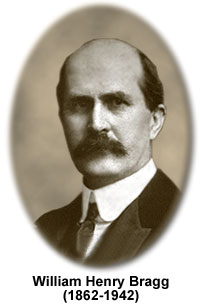William Henry Bragg
(1862-1942)

William Henry Bragg was a professor of physics and mathematics, and was known for making important contributions to many scientific disciplines. Born in Westward, Cumberland in the United Kingdom on July 2, 1862, Bragg was thoroughly educated while attending Market Harborough Grammar School and King William's College in the Isle of Man. He later went on to study physics at the Cavendish Laboratory, as well as becoming elected to the Professorship of Mathematics and Physics at the University of Adelaide, in Southern Australia. Bragg's career continued to flourish, and he was subsequently appointed Cavendish Professor of Physics at Leeds, Quain Professor of Physics at the University College London, and Fullerian Professor of Chemistry at the Royal Institution.
Bragg had numerous research interests, but the work that earned him a rank as one the great leaders in science was his historic advancements in X-ray crystallography. Working with his son William Lawrence Bragg, he developed a method of bombarding single crystals with high-energy X-rays emitted by specially constructed vacuum tubes. When X-rays pass through the single crystal, they are diffracted according to a law discovered by the Braggs and are thus quantitatively deviated from their course. Patterns of diffracted X-rays can be imaged using photographic film, because the X-rays expose grains of silver bromide when they collide. By examining the pattern of X-rays diffracted by various crystals, Bragg and his son were able to establish some fundamental mathematical relationships between an atomic crystal structure and its diffraction pattern. For this achievement, William Henry Bragg and William Lawrence Bragg were awarded the Nobel Prize in Physics in 1915.
Today, thousands of crystal structures have been determined for a wide spectrum of molecules ranging from simple organic compounds to complex multi-chained proteins and nucleic acids. X-ray diffraction has been a fundamental tool in the sciences of molecular biology and biochemistry for the past 50 years. The contributions made by X-ray diffraction experiments are almost unparalleled by any other single technique.
Throughout his career, Bragg was noted for his many contributions to a wide variety of scientific endeavors. He also had a sense of humor and is noted for the following quote on the controversy between the electromagnetic energy wave versus particle theories:
"Physicists use the wave theory on Mondays, Wednesdays, and Fridays, and the particle theory on Tuesdays, Thursdays, and Saturdays."
Bragg turned his attention to detection of sound in water during the First World War, and spent several years conducting research on the detection and measurement of sound with the intention of locating submarines. Following the war, Bragg was knighted and earned the Order of Merit in 1931. He was elected president of the Royal Society in 1935. His reputation earned Bragg honorary doctorate degrees from over 15 universities, and he was a distinguished member of many leading foreign science societies. Bragg was awarded the Royal Society's Rumford Medal in 1916 and the highest award, the Copley Medal in 1930. After a lifetime of achievement, Bragg died quietly on March 10, 1942.
